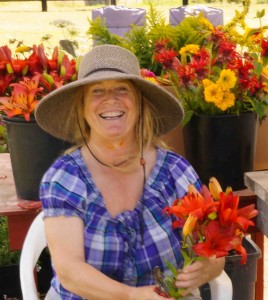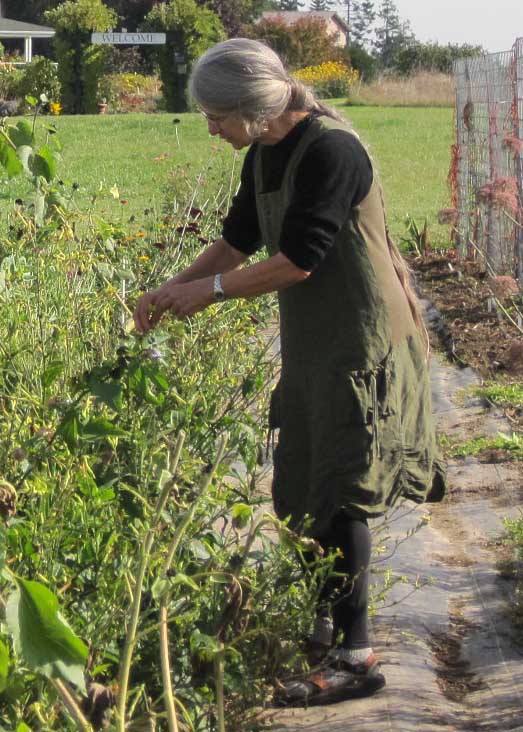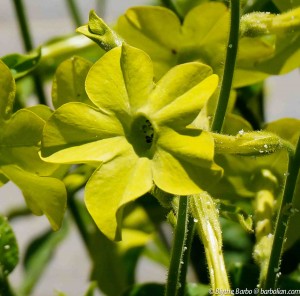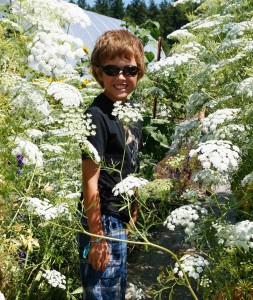Bee Walk? What does that mean? I mean, bees don’t walk much. Some say they “march,” as in marching up into the hive. But they don’t really march, either. Rather, they follow, which is interesting, considering they have the option of flying.
A Bee Walk sounds like a Moon Walk, Michael Jackson style, with a slight buzz. Hmmm. I like that idea.

So I was kind of doing some creative moves in the Willow Room when my friend, Sid Anna, who runs Annie’s Flower Farm, called to ask me if I would like to do a “Bee Walk” through her gardens. She had signed up to be one of the featured farms on Farm Tour Day and thought this would be a good activity. We could just sort of walk up and down the rows of flowers and talk about bees.
I said, “Are you kidding? I don’t know anything about bees!”
Which may surprise you.
However, in learning about bees, I have learned how little I really know. In setting up beehives, I have gained a newfound respect for native pollinators of all kinds, as well as for my honeybee companions. I am truly humbled when it comes to bees. It is not hard to convey this incompetence.
“But of course!” she encouraged. “You are perfect!”
I thought about this. Yes, we are all perfect in our own ways, and also extremely imperfect. I cannot think about something without taking it to the extreme.
Farm Tour Day is a big deal around here. For $10, you can load up the car with as many kids & adults as you can legally cram in there plus a couple more and go to a bunch of different farms where the owners graciously open their doors and set up all kinds of fun activities, good food, music, and demonstrations. It’s a hootenanny all around the town and a great time. It gets in the press and it gets a lot of applause.
For some, it’s also a bit of emotional nostalgia, because we used to be primarily a farming community around here; however, our farmland has been greatly reduced by development – the kind of urban sprawl that takes level, rich soil and turns it into cul-de-sacs for profit. We used to have 500 dairies and now we have 2. And that’s just the dairy community. But we hold on to this romantic idea that we are still a farming region, when the modern reality is, it is very difficult to eke out a living in agriculture. But the other reality is, with community support, it CAN be done – and we still have farms here to prove it. Farm Tour Day is all about community support and celebrating how blessed we are to have such abundant resources available to us. It’s about raising awareness, both for our rich heritage and for the importance of nutritious, locally grown food. The Olympic Peninsula is becoming known as a Foodie’s Paradise, so there is that economic tourism aspect to it as well.
Of course, it is a growing trend across the U.S. and in many parts of the world to stand up to Monsanto and Monsanto-like creations, and to place more value on self-sufficiency, family-farm economics, and the access to healthy, poison-free, unadulterated food. I make no apologies for this bias. We need to teach our children about the ways that used to be and to pass on the legacy that is more than history, but a way of being – a way to be strong.

(photo by M. Farley)
And so, with some hesitation, I agreed to do the Bee Walk (after all, a little stroll through the gardens from the perspective of bees – how hard can it be?), and I just hoped the weather would hold out and that there would be a few flowers left in early October. Truth be told, though, I was definitely out of my comfort zone.
Those who read my blog or otherwise know me know I have “raised” bees – which, of course, I do not – they raise themselves – for only 2 years. I am a total newbee when it comes to bees, and I freely admit this.
However – and this is a big however – I DO know about gardening for bees (and other insects). I could certainly talk about that. I could certainly talk ad nauseum (since I tend to be a yakker) about keeping track of what is blooming when, so you can know where the gaps in the food supply are and plant accordingly (let me show you my spreadsheets!). I could even talk intellectually about how flowers have adapted to the needs of the insects to increase pollination (which increases production of seed), and how, in turn, bees have adapted to flowers (to better access food supplies). It’s a mutual give-and-take system in which everyone wins. I wish Congress could learn something from bees.
Actually, when I thought about it, it is quite easy to share a fascination with and appreciation for the relationships between insects and flowers and humans. For without pollination, we would have very little food. To have pollination, we need insects – honeybees, yes, but other pollinators, too. They, like us, need a food supply that nourishes them – that helps them be strong against disease – that is free of poisons.
I began to realize this “bee walk” would be a great opportunity to share the importance of this relationship. My “comfort/discomfort zone” hardly mattered.

So – on that (thankfully!) sunny afternoon of Farm Tour Day – while I was still trying to figure out what I would talk about exactly and thinking, “Oh, what the heck, I will just ‘wing it’ (as usual) with my honeybee friends” – a few adults and a bunch of kids gathered around to begin the advertised “bee walk.” (Show time.) I handed a couple of magnifying glasses to a couple of brothers and told them they needed to share with the others, which they happily agreed to do, and off we went to “find some bees.” A young man about 10 years old was particularly knowledgeable (10-year-olds are often crammed full of facts), and we hit it off immediately. I had found a bee buddy.
As it turned out, it was the perfect time of year to walk through the flower gardens. Most would think spring or summer would be a better time because there would be more flowers, but actually, this time of year was much more interesting. What was left for the bees to eat? Actually, lots! Dahlias, Calendulas, Scabiosas, Sunflowers, Chinese Lanterns, Bachelor Buttons, Mignonette, Phlox, Cosmos, Echinacea, Nicotiana, Asters, and many many more!
When one little kid, looking through the magnifying glass, squealed, “Ooooh! Look! You can see its long tongue!” It was an ah-ha! moment. Bees are fun. They are cool. And finding them amongst the flowers is exciting!
“Aaahhh! There’s a little green frog!” And another… and another … Wow! So many little frogs! Where did they all come from?
They are a sure sign that something is Right.
And for kids of all ages, here are some interesting facts about pollinators:
- There are over 20,000 species of bees; around 4,000 of them live in North America

One might find any number of bees, ladybugs, frogs, and who knows?
(picture taken earlier in the year at Annie’s Flower Farm) - Honeybees are not native – they came to us from Europe.
- Honeybees can travel 15 miles per hour; they might fly 3 to 5 miles to find a food source!
- Their little wings can beat at 200 beats per second, which creates a BUZZ we can hear!
- Bees have five eyes, three of which are called compound eyes containing thousands of tiny prisms; the other three are simple eyes on top of the head, good for detecting changes in light.
- Many bees, such as bumblebees, are solitary bees, meaning they live all by themselves, and they often live in the ground in old mouse holes.
- Some bees have long tongues for getting deep inside long tubular flowers. Others have short tongues and prefer open-faced flowers that are easier to access.
- Some flower petals have markings that act as road signs for bees (come right this way to find the nectar!). Other flowers are like little hiding places.
- A Sunflower is a hundred flowers in one, each little flower turning into a tasty seed.
- Bees can see UV light – they love blues and purples, as well as yellow and white.
- Even birds, such as hummingbirds, can be pollinators.
- Hummingbirds love red. Many of the red flowers that attract hummingbirds have no scent; and what do you know, birds do not have a sense of smell! And guess what else – bees don’t see the color red!
- Flies, earwigs, spiders, and so many insects that we may not particularly enjoy, are also important pollinators. (I think everyone loves ladybugs, though!)

(picture taken earlier in the year at Annie’s Flower Farm)
I could go on and on about bees, flowers, pollinators, and even frogs, but suffice to say, a walk in a flower garden is much, much more than a romantic tiptoe in the tulips. It’s a step into a world where we can see not only how we have adapted to help one another, but also how we rely on one another for our very survival. It is more complex than we ever could have imagined, and something to which we should pay very close attention.
We returned from our journey, talking about bee habitat and where all the insects were going to spend the winter. It’s becoming a problem, you know, because clean and manicured yards have effectively eliminated much of this habitat – and, well, we hate to be prejudiced, but a lot of folks don’t really like bugs. I was on a mission to change that viewpoint, and so for my next activity with this inquisitive group, we were going to build an Insect Hotel – but this blog entry is already quite lengthy, so I will save that part for tomorrow’s post.
Many thanks to Sid Anna Sherwood of Annie’s Flower Farm. Your flower garden is a sensation for the senses! Thank you for providing such a beautiful, chemical-free garden for us to enjoy and better appreciate our pollinating friends. To stand in the midst of so many colors is absolutely glorious! Thank you for conducting classes on creating perfumes, crafting little tussie-mussie bouquets, teaching us about the Victorian language of flowers, showing us how to save seeds, and so many other things that help us to better understand the importance of that connection between our soil, our plants, creatures of this earth, and ourselves.
Blessings.
* * ~ ~ * *
Farms and organizations on the Farm Tour Day, October 5, 2013:
- Lazy J Tree Farm – Christmas trees, organic orchards, compost on a big scale
- Freedom Farm – horses and beef cattle and a fantastic equestrian center
- Dungeness Valley Creamery – raw milk dairy with soft-eyed Jerseys
- Nash’s Organic Produce – famous for carrots and the biggest organic farming operation this side of the Cascades – fun activities for the whole family, followed by a community potluck and barn dance!
- Jardin du Soleil – Lavender fields forever!
- Bekkavar Family Farm – One of our oldest family farms, still producing beef cattle, hogs, and hay
- Annie’s Flower Farm – A riot of color on 1 acre – stand in the middle and be surrounded by flowers and the buzzing of bees!
- Lokalie Gaare – “Lucky Sheep Farm” with working Border Collies! (My Aussie could take a few lessons here!)
- North Olympic Fiber Arts – amazing handiwork demonstrations in spinning, weaving, quilting, and more!
- Museum and Arts Center – a fantastic facility showcasing our history alongside the work of local artists